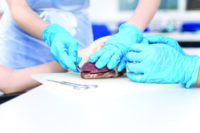Dissection can and should be part of your implementation of 3-dimensional learning. Carolina can help you make this transition with updated kits and resources.
As science teachers across all grade levels make the transition to 3-dimensional learning and the Next Generation Science Standards* (NGSS), is there still a place for dissections in the classroom? The answer is a resounding yes! Dissection labs excite students and motivate them to ask probing questions about anatomical structures and processes, to identify patterns across species, and to relate structure to function. Dissection can and should be part of your implementation of 3-dimensional learning, and Carolina can help you make this transition with updated kits and resources.
Next Generation Science Standards* (NGSS) and 3-Dimensional Learning
The NGSS and many new state standards foster 3-dimensional instruction: science and engineering practices, crosscutting concepts, and disciplinary core ideas. Well-designed science instruction should incorporate all three dimensions at every grade level, with every activity. If implemented properly, dissections address all three learning dimensions.
- Science and Engineering Practices are thinking or information-processing skills that students use while they “do” science. Dissection activities can be designed so students ask questions about external or internal anatomy, develop a model of comparative anatomy across several species, construct an explanation of anatomical changes over time, and even use their evidence and explanations to argue a scientific point such as evolution. All these student actions are scientific practices.
- Crosscutting Concepts are big ideas or concepts found across all areas of science. Dissection activities incorporate three crosscutting concepts: they foster pattern recognition when comparing systems of different species; they promote exploration of systems and generation of system models as each organ system is dissected; and they relate structure and function in any organism, plant or animal.
- Disciplinary Core Ideas are the scientific principles that students build on during their educational experiences. Dissection strongly supports the Life Science Disciplinary Core Idea LS1: From Molecules to Organisms: Structures and Processes. During dissection activities, students study the hierarchical structure of tissues, organs, and organ systems. At the microscopic level, students can compare prepared histology slides to different tissue types within an organ, relating cellular structure to important functions of the organ. At the organism level, students explore how organs work together to create a functional organ system and how organ systems work together to maintain life. For high schools, where students can complete more advanced comparative anatomy dissections, the content in LS4: Biological Evolution: Unity and Diversity should be applied. Comparative dissections allow students to discuss evolutionary changes and adaptations within and between classes of animals–insects, reptiles, amphibians, fish, and mammals.
Dissections are valuable vehicles for student learning, support 3-dimensional learning, and should be part of your curriculum going forward. However, different types of dissections address the standards at different grade levels.
Elementary School Dissections
Structure and function is a crosscutting concept for life science instruction at all age levels. In fourth grade, a specific NGSS performance expectation heavily supports dissection activities. Performance expectation 4-LS1-1 asks students to “Construct an argument that plants and animals have internal and external structures that function to support survival, growth, behavior, and reproduction.” A physical dissection provides students with the evidence needed to make an argument that internal and external anatomical structures support survival.
Flower Dissection
An excellent starting point for young students is flower dissection. Flowers can be obtained from local grocery stores or florists, and their dissection does not require sharp cutting tools. A magnifying glass unlocks close observation of external flower anatomy related to plant survival and is all that is needed to examine the reproductive parts of flowers during the dissection.
Bullfrog and Squid Dissection
Students may also dissect animal specimens and relate structure to function while exploring characteristics that support survival. Bullfrogs are an excellent choice for a first dissection. Students can examine the external anatomy of the frog and discuss the advantages of the frog’s coloration, webbed feet, and muscular tongue, for example. Dissecting scissors and a couple incisions through skin and muscle reveal the internal organs, which are easily seen as distinct entities. As students explore the internal anatomy, have them explain why structures, such as the fat bodies and intestine, are important to survival.
Squid are also great introductory specimens for elementary-age students. Like frogs, they can be dissected using only dissecting scissors and have highly specialized external and internal features that support their survival, growth, and behavior. Color-changing chromatophores, long tentacles with suction cups, a beak, and gills are just a few examples of these characteristics.
If you feel that your students are not ready to dissect their own specimens, you may wish to prepare several preserved bullfrogs or squid so students can observe external and internal structures. Have students draw out the internal structures and label them. Then discuss the importance of each of these structures.
Middle School Dissections
In middle school, the depth and complexity of learning required by the performance expectations increase as the theme of structure and processes remains constant. Students are expected to make additional connections among subsystems and closely relate structure to function for the nervous system. MS-LS1-3 expects students to “use argument supported by evidence for how the body is a system of interacting subsystems composed of groups of cells.” The assessment boundary for MS-LS1-3 states that assessment should be limited to the circulatory, digestive, respiratory, muscular, and nervous systems. A dissection is an ideal hands-on activity for students to explore and obtain firsthand evidence of these body systems. Following are the Disciplinary Core Ideas and related Performance Expectations that dissection builds toward in middle school.
| Disciplinary Core Idea | Performance Expectation |
| LS1.A: Structure and Function In multicellular organisms, the body is a system of multiple interacting subsystems. These subsystems are groups of cells that work together to form tissues and organs that are specialized for particular body functions. |
MS-LS1-3: Use argument supported by evidence for how the body is a system of interacting subsystems composed of groups of cells. |
| LS1.D: Information Processing Each sense receptor responds to different inputs (electromagnetic, mechanical, chemical), transmitting them as signals that travel along nerve cells to the brain. The signals are then processed in the brain, resulting in immediate behaviors or memories. |
MS-LS1-8: Gather and synthesize information that sensory receptors respond to stimuli by sending messages to the brain for immediate behavior or storage as memories. |
| LS4.A: Evidence of Common Ancestry and Diversity Anatomical similarities and differences between various organisms living today and between them and organisms in the fossil record, enable the reconstruction of evolutionary history and the inference of lines of evolutionary descent. |
MS-LS4-2: Apply scientific ideas to construct an explanation for the anatomical similarities and differences among modern organisms and between modern and fossil organisms to infer evolutionary relationships. |
Both full-animal dissections and organ dissections provide excellent opportunities to study the organ systems.
Animal Dissections
A complete line of Carolina’s Young Scientist™ Dissection Kits facilitates the laboratory experience for middle school students. Dissecting an animal specimen allows students to explore the organs that make up each organ system, which all function together to allow survival. Each one of these kits will provide your students with firsthand knowledge of how the organism is a system of interacting subsystems. The evidence gathered by students through dissection is then used to generate claim-evidence-reasoning statements. For system comparisons, Carolina’s Young Scientist™ Animal Dissection Kit offers students the experience of gathering evidence of system structure from four species: an earthworm, a crayfish, a grasshopper, and a frog. Students can compare the complexity of digestive, circulatory, nervous, and reproductive systems among the four animals. From this dissection, students not only explore the subsystems of each animal but can also construct an explanation for how these specimens are related in evolutionary history based on their observations.
Brain and Eye Dissections
As shown in the chart above, the middle school standards call out sensation and perception in MS-LS1-8.This performance expectation is easily addressed when students dissect a sheep brain and/or cow or sheep eyes. When dissecting an eye, students get an up-close look at the location of photoreceptors and at the pathway nerve impulses travel to the brain. The instructions in the Carolina’s Young Scientist™ Eye Dissection Kit and in the Mammalian Eye Dissection BioKit® make it easy to locate the important structures of the eye and understand each structure’s function. During the brain dissection, students examine the actual parts of the brain where signals are interpreted. We recommend Carolina’s Young Scientist™ Brain Dissection Kit or the Mammalian Brain Dissection BioKits®, depending on your class needs.
If you purchase the specimens individually, Carolina offers a line of low-cost, reusable dissection mats that walk students through the dissection and identify all the key structures. Each mat has labeled, full-color photographs and concise instructions to help facilitate the dissection. There are dissection mats available for both the brain and eye.
At the middle school level, dissections provide students with the perfect venue to ask questions and construct explanations about what they observe. Their observations allow them to explain the hierarchical organization of systems in animals and infer evolutionary relationships. Dissection gives them a hands-on experience that they will never forget. Carolina’s broad line of products and customer support make it easy for you to include dissections as NGSS activities.
High School Dissections
| Disciplinary Core Idea | Performance Expectation |
| LS1.A: Structure and Function Multicellular organisms have a hierarchical structural organization, in which any one system is made up of numerous parts and is itself a component of the next level. |
HS-LS1-2: Develop and use a model to illustrate the hierarchical organization of interacting systems that provide specific functions within multicellular organisms. |
| LS4.A: Evidence of Common Ancestry and Diversity Genetic information, like the fossil record, provides evidence of evolution. DNA sequences vary among species, but there are many overlaps; in fact, the ongoing branching that produces multiple lines of descent can be inferred by comparing the DNA sequences of different organisms. Such information is also derivable from the similarities and differences in amino acid sequences and from anatomical and embryological evidence. |
HS-LS4-1: Communicate scientific information that common ancestry and biological evolution are supported by multiple lines of empirical evidence. |
When students reach high school, dissections can be used as evidence for model building and as empirical evidence to support theories. The chart below outlines the disciplinary core ideas and performance expectations dissection builds toward in high school. Dissection of a small mammal is a hands-on approach for students to gather information on organs and organ systems necessary to develop a model of interacting systems that is also applicable to larger mammals, such as humans. Student-created models may include color-coded diagrams, analogies, physical replicas, and more. The Carolina BioKits® Dissection Series provides the materials and support needed to ensure student success and lessen teacher stress.
Pig Dissection
Our most popular mammalian dissection specimen in high school biology is the preserved fetal pig. Pig dissection allows students to examine tissues, organs, and organ systems and to develop models of the hierarchical organization of these components. In addition, students can relate the structure of organs to their function.
Pigs are also considered “translational research models,” which means they have several similarities with humans. As students explore the external and internal structures, encourage them to draw parallels between pig and human anatomy. For example, the heart and kidneys look and function the same in pigs as they do in humans. These similarities make preserved pigs the perfect specimens to address the NGSS performance expectation about common ancestry and diversity, which notes that similarities among anatomical structures is a line of supporting evidence for common ancestry. As students study each organ system, they continue to gather evidence, supporting common ancestry.
Carolina also offers several comparative anatomy kits that allow students to observe anatomical similarities and differences and infer evolutionary relationships. The Cladograms and Evolution Kit has students observe the external morphology of several preserved specimens and create a cladogram based on their findings. Then, when comparing the amino acid sequence of the cytochrome c protein from each specimen, they revisit their initial cladogram. Using both lines of empirical evidence, students deduce the phylogenetic order of the specimens. Carolina also offers the Comparative Vertebrate Anatomy Kit and Comparative Circulatory System Kit, which build toward the disciplinary core idea addressing evidence of common ancestry and diversity.
Rat Dissection
Performing a rat dissection is a cost-effective lab activity that allows students to study the components and systems of a mammalian specimen. Students can compare external and internal anatomy to other mammals, identify organs within a system, and examine the spatial relationships among organ systems. The rat, like the pig, allows teachers to meet the same education objectives but on a smaller scale. The Advanced Rat Dissection BioKit® includes 15 specimens and a comprehensive teacher’s manual and student guide. Like all dissection BioKits®, it is available with or without 15 dissection mats.
Helpful Resources
Dissections present a myriad of possibilities for exciting students and creating 3-dimensional learning environments in your classroom. To maximize deep student learning, teachers should explicitly integrate all three dimensions. Carolina will continue to offer resources to help you seamlessly integrate disciplinary core ideas, science and engineering practices, and crosscutting concepts.
If you need additional help selecting the right specimen to meet your educational needs, our comprehensive Dissection Buying Guide helps you compare specimens, guides you to choose appropriate dissection and safety supplies, and gives you options for instructional materials. Don’t pass up the opportunity to let your students experience science from a researcher’s perspective.
Let Carolina help you dissect NGSS and 3-dimensional learning!





2 Comments
Hi-
Would there be any way to get a printable or pdf version of this article? I’d like to use it as a jigsaw in my science meeting.
Eva
Hi Eva! We do not have this as a downloadable article. But, if you would like to save this web article, you can CTL+P like you would print and change the destination to “Save as PDF”, and it would save that way for you.